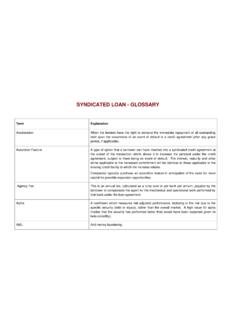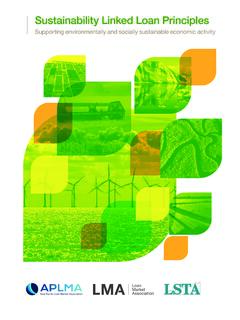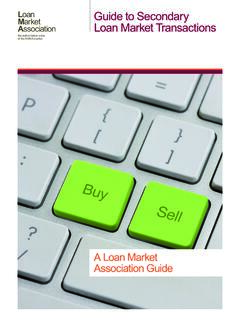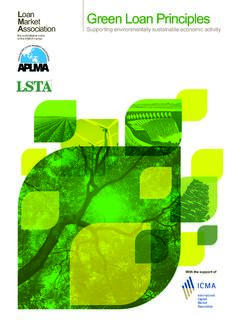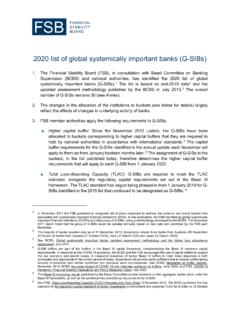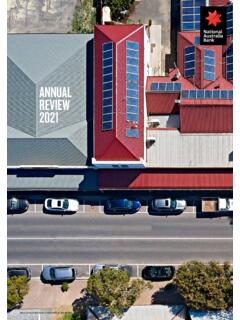Transcription of A Loan Market Association Guide - lma.eu.com
1 A Loan Market Association GuideA Loan Market Association GuideGuide to Syndicated Loans & Leveraged Finance TransactionsSyndicated LoansTypes of SyndicationDocumentationStructure & ProcessLoan Transfers A LOAN Market Association Guide A Guide TO SYNDICATED LOANS & LEVERAGED FINANCE TRANSACTIONS Loan Market Association 10 Upper Bank Street, London E14 5JJ Loan Market Association 2013 Published by the Loan Market Association in October 2013 10 Upper Bank Street, London E14 5JJ Telephone: +44 (0)20 7006 6007 Fax: +44 (0)20 7006 3423 Email: Website: All rights reserved. No part of this publication may be reproduced, stored in any retrieval system or transmitted in any form or by any means, electronic, mechanical, photocopying, recording or otherwise, without prior written permission of the copyright holder, for which application should be addressed in the first instance to the publishers. No liability shall attach to the authors, the copyright holder or the publishers for loss or damage of any nature suffered as a result of the reproduction of any of the contents of this publication.
2 The views and opinions expressed in this publication are the views of the authors. The Loan Market Association and the authors have made every effort to ensure the complete accuracy of the text but none of the Loan Market Association , the authors or the publishers can accept any legal responsibility or liability for any error or omission in its contents. This " Guide to Syndicated Loans & Leveraged Finance Transactions" is not intended to be completely comprehensive. Rather, it seeks to provide guidance on various aspects of syndicated loans and leveraged finance transactions. Most importantly, this publication is not designed to provide legal or other advice on any matter whatsoever. The Loan Market Association The Loan Market Association (LMA) is the trade body for the Europe, Middle East and Africa (EMEA) syndicated loan Market and was founded in December 1996 by banks operating in that Market . Its aim is to encourage liquidity in both the primary and secondary loan markets by promoting efficiency and transparency, as well as by developing standards of documentation and codes of Market practice, which are widely used and adopted.
3 Membership of the LMA currently stands at over 500, covering 50+ nationalities, and consists of banks, non-bank lenders, law firms, rating agencies and service providers. The LMA has gained substantial recognition in the Market and has expanded its activities to include all aspects of the primary and secondary syndicated loan markets. It sees its overall mission as acting as the authoritative voice of the EMEA loan Market vis vis lenders, borrowers, regulators and other interested parties. Guide TO SYNDICATED LOANS & LEVERAGED FINANCE TRANSACTIONS 2 CONTENTS Page Number INTRODUCTION 3 PART I SYNDICATED LOANS 4 1. TYPES OF SYNDICATION 5 2. TYPES OF FACILITY 6 3. PARTIES TO A SYNDICATED LOAN 8 4. DOCUMENTATION 10 5. TIMING 12 6. LOAN TRANSFERS 13 PART II LEVERAGED FINANCE LOANS 14 7. STRUCTURE OF A LEVERAGED FINANCE TRANSACTION 15 8. TYPES OF FACILITY 17 9. PARTIES TO A SENIOR LEVERAGED FACILITIES AGREEMENT 19 10. DOCUMENTATION FOR A LEVERAGED ACQUISITION FINANCE TRANSACTION 20 11.
4 MANDATORY PREPAYMENTS/FINANCIAL COVENANTS 24 12. TIMING/PROCESS 26 13. LEVERAGED ACQUSITION FINANCE TRANSFERS 27 Guide TO SYNDICATED LOANS & LEVERAGED FINANCE TRANSACTIONS 3 INTRODUCTION Syndicated loans started as a way of allowing lenders to lend large sums of money to a single borrower, where the sums involved went far beyond the credit appetite of a single lender. Whilst the precise year is disputed, it is thought that the first syndicated bank loan agreement was executed in the London Market in 1968, with syndications developing in the 1970s as a sovereign business. Over time, the range of borrowers to whom lenders made syndicated loans widened, lenders initially providing syndicated loans to corporate entities with very high credit ratings ('investment grade loans') before branching out, towards the end of the twentieth century, to provide loans to those companies with a lower credit rating, including 'leveraged loans' (for further discussion of which see Part II).
5 In addition, a conscious effort was made to develop a secondary Market in syndicated debt, enabling the growth of the syndicated loan Market through the opening of that Market to non-bank investors and through providing banks with a way to manage their loan portfolios and therefore continue to provide liquidity for new transactions. Today, non-bank investors are active in both primary and secondary markets. This paper is split into two parts. Part I will provide guidance on various aspects of an investment grade syndicated loan transaction, focusing on the following: 1. the types of syndication commonly seen in the loan Market ; 2. the types of borrowing facilities commonly seen in a syndicated loan agreement; 3. a description of the parties to a syndicated loan agreement and an explanation of their role; 4. a brief explanation of the documentation entered into by the parties; 5. the time line for a typical syndicated loan transaction; and 6. a description of the common methods used by lenders to transfer syndicated loan participations.
6 Part II will set out an example of the structure commonly seen in a senior facilities agreement for a leveraged acquisition finance transaction and provide guidance on those aspects of a leveraged acquisition finance transaction which are different to an investment grade syndicated loan transaction. Guide TO SYNDICATED LOANS & LEVERAGED FINANCE TRANSACTIONS 4 PART I SYNDICATED LOANS The guidance in this Part of the paper is given on the basis of a typical investment grade syndicated loan transaction undertaken in the European loan Market as envisaged in the LMA Primary Loan documents and governed by the laws of England. Whilst the documents are drafted for investment grade corporates, in practice they are used for a variety of borrowers across the credit spectrum with appropriate amendments. This Part is not intended to provide a detailed explanation on the provisions of the LMA Primary Loan documents - guidance on this is set out in the "Users Guide to Investment Grade Primary documentation" published by the LMA and available to LMA members on the LMA website.
7 Guide TO SYNDICATED LOANS & LEVERAGED FINANCE TRANSACTIONS 5 Section 1 TYPES OF SYNDICATION An investment grade syndicated loan is usually a multi-lender transaction, where lenders (usually banks but sometimes including non-bank investors) contract with a borrower to provide a loan on common terms and conditions governed by a common document (or sets of documents). Each lender acts on a several basis, whereby if a lender fails to honour its obligations as a member of the syndicate, the other syndicate members have no legal duty to satisfy these obligations on that lender's behalf. A syndicated loan may be arranged on an underwritten or best-efforts basis, or by way of a club deal. These three types of deal are explained in more detail below. A. UNDERWRITTEN DEAL An underwritten deal is one for which the arrangers guarantee the entire commitment, and then syndicate the loan. If the loan is not fully subscribed, the underwriters will be obliged to lend the underwritten sum of money to the borrower themselves.
8 The underwriters may later try to sell their commitment (or part of their commitment) to investors in the secondary Market . Underwritten loans therefore usually attract higher fees than loans syndicated on a best-efforts basis. B. BEST-EFFORTS DEAL A best-efforts deal is one which is not underwritten by the arrangers. The arrangers will commit to a certain amount of the loan, and undertake to do their best to find other lenders to provide commitments for the remainder. However, the arrangers do not guarantee that they will succeed in this. The borrower therefore bears the risk that in the event that the arrangers fail to attract commitments for the total amount of the loan, the borrower will not receive sufficient C. CLUB DEAL A club deal will usually involve a loan that is pre-marketed to a group of relationship banks. The borrower may arrange the club loan itself, or alternatively, an arranger may be involved. Guide TO SYNDICATED LOANS & LEVERAGED FINANCE TRANSACTIONS 6 Section 2 TYPES OF FACILITY Two types of loan facility are commonly utilised: term loan facilities and revolving loan facilities (within which there are options for swingline facilities, multicurrency-borrowing, etc.)
9 Syndicated loan agreements for an investment grade transaction may contain only a term loan or revolving facility, or they may contain a combination of both. There can be one borrower or a group of borrowers with provisions allowing for the accession of new borrowers under certain circumstances, from time to time. The facility may also include a guarantor or guarantors and again provisions may be incorporated allowing for additional guarantors to accede to the agreement. It is this flexibility which has enabled the syndicated loan Market to remain a dominant provider of capital to the many and varied borrowers that use it. A. TERM LOAN FACILITY Under a term loan facility, the lender commits to lend to the borrower a specified amount of money over a set period of time (the "term"). The period of a corporate term loan is generally between one and five years. Typically, the borrower is allowed a short period after executing the loan agreement (the "availability period"), to draw loans up to a specified maximum facility limit.
10 The borrower will typically pay commitment fees in respect of committed undrawn amounts during the availability period. Interest on syndicated loans usually accrues at a floating rate (rather than a fixed rate, which is more usually found in the bond Market ). This variable rate of interest is reset periodically, the periods more frequently used being one, three and six months. The loan may be repaid in instalments (in which case the facility is commonly described as "amortising") or through one payment at the end of the facility (in which case the facility is commonly described as having "bullet" repayment terms). Prepayment of the loan is commonly permitted without penalty (one of the advantages of a syndicated loan to a borrower vis- -vis a bond) but, in any event, amounts that are repaid (or pre-paid) may not be re-drawn. B. REVOLVING LOAN FACILITY A revolving loan facility is similar to a term loan facility in that it provides a borrower with a maximum aggregate amount of capital, available over a specified period of time.
